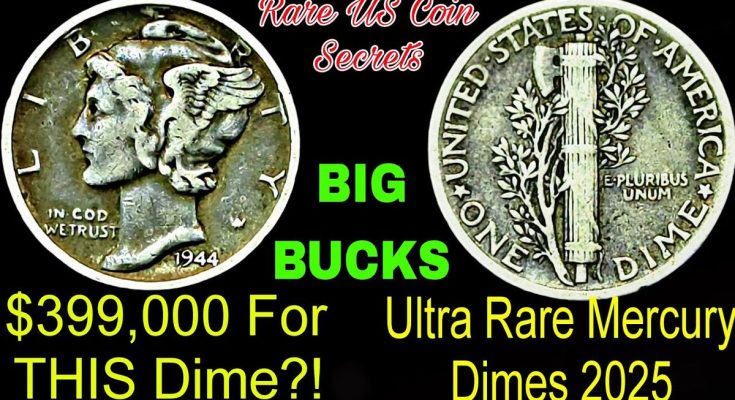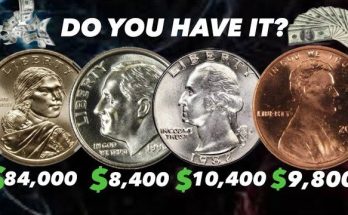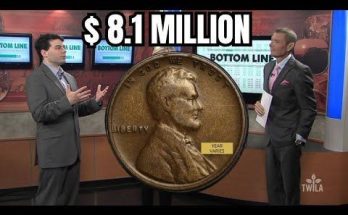Don’t Sell These Top 6 Valuable Mercury Rare Dimes — They’re Worth Top Dollars!
The Mercury Dime, officially known as the Winged Liberty Head Dime, is one of the most beloved and historically significant coins in American numismatics. Minted from 1916 to 1945, this beautiful 90% silver coin features Lady Liberty donning a winged Phrygian cap, mistakenly thought to be the Roman god Mercury by the public, hence its enduring nickname. While many circulated Mercury Dimes are worth their silver melt value—typically just a few dollars—a select few are monumental rarities that can command thousands, or even hundreds of thousands, of dollars at auction.
If you’re a coin collector, or simply have an old collection sitting in a drawer, it’s crucial to know which dates and varieties hold the true “top dollar” value. Selling one of these rare pieces for a pittance is every collector’s nightmare! Before you sell any of your dimes, check for these top six valuable Mercury Dime rarities.
The Keys to High Value: Condition and Full Bands
The value of any Mercury Dime is heavily dependent on two primary factors: its condition (grade) and the presence of Full Bands (FB).
- Condition: A coin that is uncirculated (Mint State or MS) will always be worth significantly more than a circulated piece. The best-preserved coins, often graded MS-65 or higher, are the ones that fetch the highest prices.
- Full Bands (FB): This designation refers to the clear, sharp separation of the three horizontal bands that bind the fasces (bundle of rods) on the reverse of the coin. Due to weak strikes in production, finding this detail fully visible is rare, and it can skyrocket the coin’s value, turning a valuable coin into an ultra-rarity worth six figures.
The Top 6 Most Valuable Mercury Dimes
1. The Undisputed King: 1916-D Mercury Dime
The 1916-D is the absolute key date of the entire Mercury Dime series, boasting the lowest mintage of only 264,000 coins. This incredibly small number was a result of the Denver Mint being ordered to prioritize the production of quarters that year.
The scarcity means that even in low circulated grades, a 1916-D can be worth hundreds of dollars, starting around $\$650$. However, a pristine example in mint condition is a true numismatic treasure. The record price for an exceptional grade 1916-D is up to $\$195,500$ for a “Full Bands” specimen. Look for the tiny ‘D’ mint mark, located on the reverse, just to the left of the fasces base.
2. The High-Value Error: 1942/1 Overdate (Philadelphia & Denver)
This is not a key date due to low mintage, but rather a spectacular mint error variety. The 1942/1 Overdate occurred when the die for the year ’42’ was mistakenly punched over a die already stamped with ’41’. You must examine the date closely, especially the last digit, to spot the remnants of the ‘1’ underneath the ‘2’.
Both the Philadelphia (no mint mark) and Denver (‘D’ mint mark) issues of this overdate are highly prized. The Denver issue, the 1942/1-D, is the most famous, with high-grade examples reaching a value of over $\$40,000$. One example of the 1942/1 (Philadelphia) overdate sold for $$90,000 in 2023.
3. The Great Depression’s Rarity: 1921-D Mercury Dime
Following the 1916-D, the 1921-D has the second-lowest mintage in the series, with only 1,080,000 pieces struck. Minted during an economic downturn after World War I, production of dimes was low across the board.
This low mintage makes it a semi-key date, with values starting in the double digits for circulated coins. However, uncirculated specimens in high grades are incredibly difficult to find, pushing their value to over $$28,800.
4. The Philadelphia Counterpart: 1921 Mercury Dime (No Mint Mark)
The Philadelphia Mint’s production was also severely limited in 1921, with a mintage of only 1,230,000 coins. Like its Denver counterpart, the regular 1921 issue is a highly sought-after semi-key date.
The value for a circulated 1921 dime can start around $\$35-\$60$, but once you find one in top-tier mint state condition, its value can climb significantly, with auction results reaching over $$23,500.
5. Full Bands Potential: 1919-D Mercury Dime
While the overall mintage of the 1919-D was nearly 10 million, what makes this date exceptionally valuable is the Full Bands distinction. Coins from this year and mint typically exhibit a weak strike, meaning specimens with full details on the fasces are exceedingly rare.
A circulated 1919-D is common, but one of the finest known examples with the “Full Bands” distinction sold for a staggering $$218,500 at auction in 2000. This demonstrates the massive premium attached to the ‘FB’ designation, particularly for early-date D-Mint issues.
6. The San Francisco Low Mintage: 1926-S Mercury Dime
The San Francisco Mint (S-mint mark) produced several low-mintage key dates, and the 1926-S is a prime example. With only 1,520,000 minted, it is one of the lowest-mintage coins in the entire series.
Like other rare dates, its value is tied to its condition. Circulated examples start in the double digits, but higher-preserved coins are extremely scarce. The 1926-S has an estimated value that can reach over $$6,000 in high grades due to this combined low mintage and scarcity in choice condition.
Don’t Sell Too Soon! Get an Appraisal
The difference between a common Mercury Dime and a six-figure treasure often comes down to a tiny mint mark, a minute error, or an exceptional lack of wear. If you believe you have one of these top six valuable Mercury Dimes, do not clean it and do not sell it immediately. Cleaning a coin can drastically reduce its value. Instead, consult a certified numismatist or a professional coin grading service (like PCGS or NGC) to get an accurate appraisal of your coin’s condition and true market value. The rare beauty in your possession could truly be worth top dollars!



